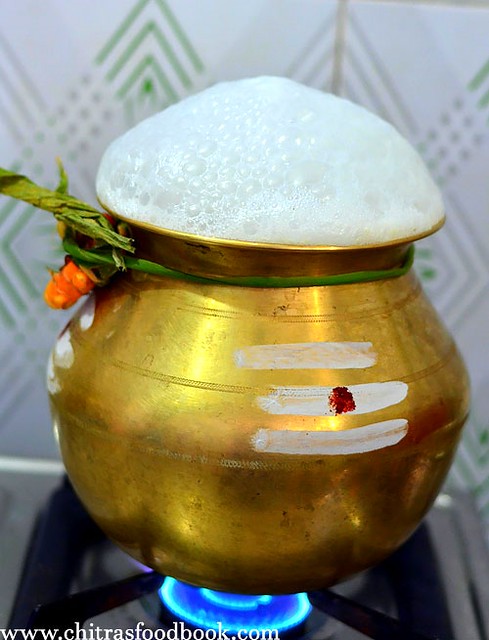
Hello Friends, Today’s post is all about the most popular Tamil festival, Thai Pongal celebration at home (also known as Makara Sankranti in other parts of India) along with Pongal recipes link. I have shared the details about Pongal Festival/Makar Sankranti and its pooja procedures of our home along with pictures of our last year celebration. It is purely of Tamil nadu style and it may vary as per your custom and tradition. So this post would be more of essays with images. Please excuse me. I hope this post would help beginners and newly wedded girls to start their Thai pongal festival celebration on their own.
Pongal (Thai pongal/Surya pongal) is a harvest festival of Tamilnadu, South India. It is one of the most important and popular Hindu festivals. This four-day long harvest festival of Tamil Nadu, Pongal is all about thanksgiving to nature and takes its name from the Tamil word Pongal means “boiling over” and is held in the month of Thai (January-February). ‘Pongal’ literally means overflowing and is named so because of the tradition of cooking the new rice in pots until they overflow, which is a symbol of abundance and prosperity.
Pongal is usually celebrated from January 13 to 16 every year. In 2024, Pongal celebration takes place from January 15-18. The main festivities starts on January 14/ bhogi day. Pongal festival is on January 15th, Monday. This festival marks a period of plenty, peace and happiness. On the first day known as Bhogi, people clean their homes thoroughly and in the evening, all unwanted goods are lit in a bonfire. The second day is Perum Pongal, the most important. It is also called Surya Pongal because people worship Surya, the Sun God and his consorts. Women decorate the central courtyard of their homes with beautiful kolams (Visit my in-laws blog for kolam ideas), done with rice flour and bordered with red clay.
Click this kolam picture to view pongal kolam designs from my in-laws blog 🙂
Disclaimer : I have shared the procedures based on our tradition. Please take this as a reference, consult the elders of your family and do the pooja as per your practice. Beginners can follow this if you don’t have any specific procedure at home.
Please watch the video below for making sakkarai pongal in venkala paanai / sweet pongal in bronze pot
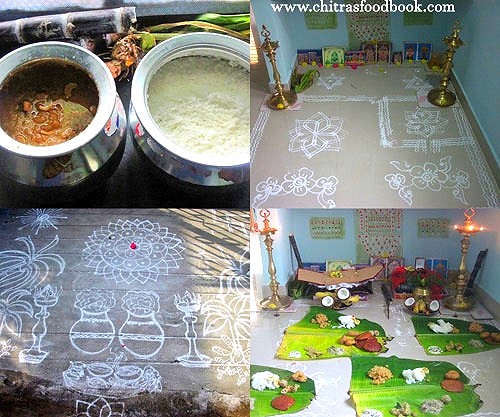
What is Pongal Dish ?
The most important part of the Pongal festival is cooking the Pongal dish. A sweet version of pongal called Sakkarai pongal is made with rice mixed with moong dal and cooked with ghee, cashew nuts, raisins adding jaggery (a type of unrefined sugar). A spicy pongal called Ven pongal/Ghee pongal is also prepared adding lots of ghee and spices like pepper & cumin.
Things required for pongal celebration
- Pongal Pot – Either Clay pot or bronze pot or pressure cooker
- Clay stove – If using (optional)
- Rice flour & color powders for kolam – Click here for rangoli/kolam designs
- Manjal kothu/Turmeric plant
- Mango leaves/Maavilai
- Banana leaves ( we use 5 to 7 leaves)
- Betel leaves & nuts(Vetrilai paaku)
- Banana
- Coconut
- Sugarcane
- Vegetables for offering God like sweet potato, yam, panag kizhangu, pumpkin, arbi, raw banana, field beans, all country vegetables.
Ingredients required for cooking
Usually we make Sweet pongal, white pongal/paal pongal, Sambar with 7 vegetables, Poriyal or kootu, Thayir pachadi, Paruppu/dal along with Vada, Suzhiyan & adhirasam. Click HERE for Pongal recipes collection. Visit my in-laws blog for kolam ideas.
- Raw rice / pacharisi
- Moong dal
- Jaggery ( Buy sugar candy if making kalkandu pongal)
- Milk
- Water
- Cardamom seeds
- Jathikai/Nutmeg
- Edible camphor
- Ghee
- Cashews, dry grapes, cloves
- Salt
- Toor dal
- Urad dal for vada
- Rice flour & jaggery for adhirasam(optional)
- Chana dal, jaggery, maida, rice flour ( for making suzhiyan, optional)
- 7 vegetables ( broad beans, sweet potato, cluster beans, raw banana, yam, arbi, field beans, pumpkin)
- Gooseberry or Lady’s finger for pachadi
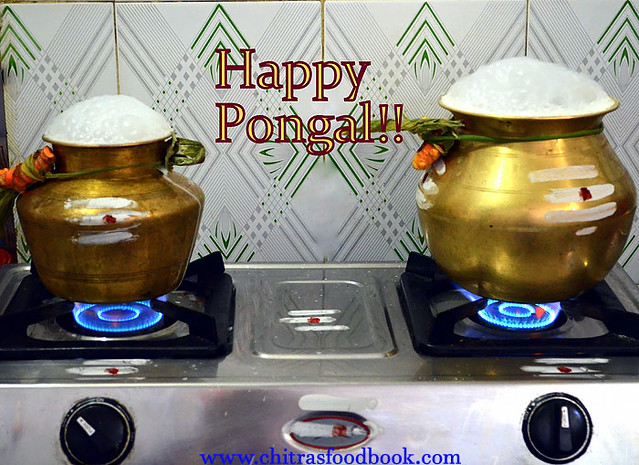
Pongal festival – Pre Preparation
On bhogi day, wash and clean the entire house. Clean doors, windows & keep turmeric, kumkum dots. If you have the practice of burning old things, you can do it on this day. We used to discard the old clothes. Wash all the blankets, pillow cover, screen cloth. Wash the lamps and other pooja vessels. Decorate it and keep it ready for next day pooja. If using clay pot & stove buy them. If using cooker or bronze pot, wash and keep it ready. Tie the manjal kothu around the pot. Draw three lines with wet viboodhi (pattai) and keep a kumkum dot on the pot.
On Pongal day, wake up at early morning 4am because we are supposed to do the pooja during sunrise at around 6am. So wake up early and take head bath. Some people make pongal at the auspicious time of the day. So you can plan accordingly.
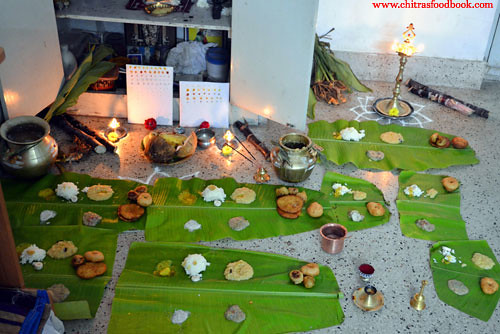
Pongal Pooja Procedure
Generally Pongal neivedyam is for Sun God. But we do it for our Veetu theivam, Maga maayi and Sun God. So we have offered all the dishes in 9 leaves. But in general, spread 5 leaves for Sun God.
To make a simple pooja, just spread two banana leaf in the backyard/ terrace or pooja room. Light two lamps on both the sides. Keep the vegetables on the banana leaf. Keep a uzhakku full of rice. Place the coconut, betel leaves and nuts. In another banana leaf, spread the cooked sweet pongal, paal pongal and seven vegetable kootu. Offer to Sun God and do the pooja.
Prayers Chanted on Pongal
Aditya Hridayam or Surya Ashtotaram or Gayatri mantra can be recited Or you can simply mediate and say some simple prayers.
After The Pongal Puja
After the prayers, some water and flowers are sprinkled on the kolam and pongal dish. You can also sprinkle some uncooked rice mixed with turmeric (akshata).
After final prayers, pongal, other dishes and fruits are distributed.
Looking at Sun’s reflection in water
In some regions, there is a ritual to look at the Sun’s reflection in a vessel filled with water. Some communities add turmeric and kumkum to the water and look at this reflection. Another unique ritual is to look at sun through the gaps of fingers.
Source : The hindu blog
Disclaimer : I have shared the procedures based on our tradition. Please take this as a reference, consult the elders of your family and do the pooja as per your practice. Beginners can follow this if you don’t have any specific procedure at home.

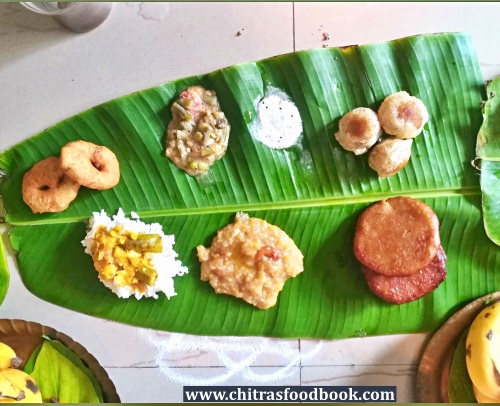
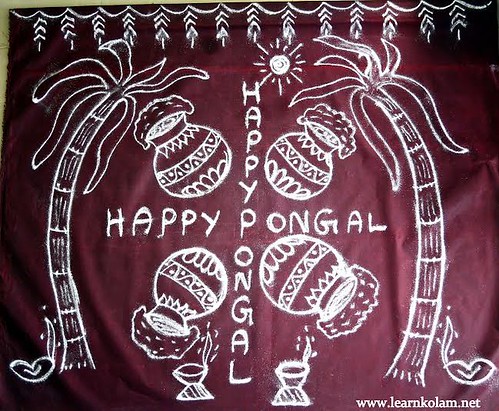
Leave a Reply